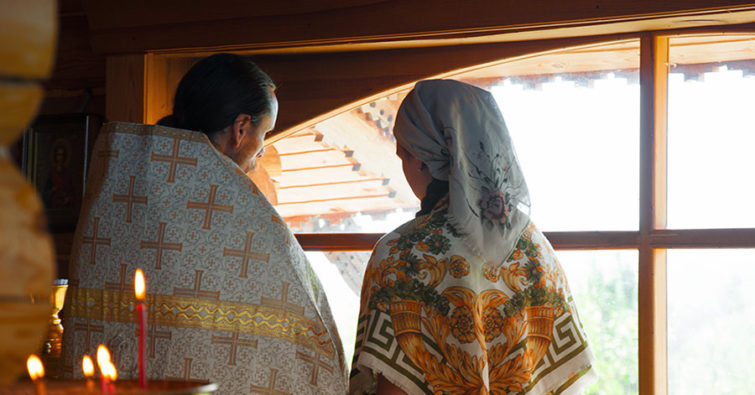Careful exegesis may seek to see whether the apostle, with the precept of monogamy, forbids any other kind of marriage or only certain kinds of existing marital practices. In addition to monogamy, the following 6 types of attitudes towards marriage are possible: 1) virginity; 2) celibacy after the first divorce; 3) widowhood after the death of the first wife; 4) simultaneous digamy or polygamy, ie. marriage to two or more women at the same time; 5) digamy or polygamy not in its own sense, ie. concubinage, violation of the purity of married life; 6) consistent digamy or polygamy, ie. marriage after the loss of one or more wives, regardless of the cause of the divorce (death, divorce).
Celibacy, according to the apostle, is an aid “for decent and constant service to the Lord – unhindered.” Analyzing in the seventh chapter of his first epistle to the Corinthians the present state of human life in its two basic forms — celibacy, virginity, and marriage — he gives precedence to the first form. Marital life is completely natural, but in terms of achieving salvation it is less comfortable. In his day, the desire for celibacy was so strong that many felt obligated not only to remain celibate, but it was even thought that those who had already entered into a marriage should separate. Therefore, the app. In his epistles Ephesians (5: 22-23) and Timothy (4: 2-3), Paul zealously defends the meaning of marriage.
In the New Testament language there are a number of lexical Latinisms, especially of a legal nature. Thus the parallelism of “a man of one woman” (“enos andros gini” – 1 Tim. 5: 9, where he speaks of the widow of a single man, alien to any deviation from monogamy, ie residing in the most strict monoandria = monogamy) may be an accurate translation of the Latin legal term “univira” or “uni nupta viro”.
For both Greeks and Romans, marriage was sacred and one-time. Women who entered into subsequent marriages, in “multarum nuptiarum”, were not respected and only women, matronae, who were satisfied with one marriage, according to the Roman writer, were crowned with the crown of chastity (cf. Valer. Maxim. II, 1). , 3). Monogamy was mandatory for some priests in ancient Rome. The priests of the deity Fortuna Milieris could not be married; pontificesa maximi and flamines. And the latter could not be widows, which Latin writers describe with the technical formula “non bimariti”.
Opponents of remarriage (or subsequent polygamy) identify themselves: James Chrystal (Authoritative Christianity, New Jersey, 1895, p. 15); Ch. Ellicott (The Pastoral Epistles of St. Paul, 5th ed., London, 1883, p. 41); Ep. Ioan Sokolov (On the monasticism of bishops, Kazan, 1863, p. 5); Holy Michael the Trinity, (Epistles of St. Paul to Timothy and Titus, Kiev, 1884, pp. 137-146). This thesis was also influenced by St. Epiphanius of Cyprus, who recognized the remarriage of the clergy as a church rule of apostolic, even divine, origin. He sympathized with celibacy and its influence on the development of the sacramental legislation was expressed in the extension of its validity to the subdeacon’s degree. In his work On Heresies, in which he exposes the Montanists, he gives us indirect proof that the 2nd Apostolic Decree or the 17th Apostolic Rule, placed together with the Didascalia, was drawn up at the council against the Montanist heretics. “The second married is not allowed to receive a sacred ordination in the church, even if he has abstained from women, or he has been a widower, understanding episcopal, presbyterian, and deaconly” (Epiphanius of Cyprus, Against Heresies, Moscow, 1864, vol. III , ch. 20, Creations, part V, p. 352).
In Orthodox Russia for a long time the view of the opponents of the second marriage prevailed among the clergy, reaching even the strange theory of the miter. Filaret, developed by him in his message to Pskov from 1425, which is expressed in the following statement: since man and woman are one flesh, a priest who has lost his wife is as if deprived of half of his person and being and becomes half-alive, half-dead, so he can no longer be a parish priest, but must retire to monastery or to forbid him to officiate. This practice was legalized at the Moscow Council of 1503, lasted until the Council of Moscow in 1667 and was finally banned by a special law on April 16, 1869. Many Orthodox canonists are in defense of the second marriage of the clergy, interpreting the words of the apostle as a prescription for monogamous marriage and the prohibition of simultaneous polygamy or only illegal polygamy, but not consistent. Such an understanding of the sacramental formula is also advocated by Ep. Nicodemus in defense of consistent polygamy, as marriage should always be monogamous, but that is why church law allows second and third marriages. “The spirit of the ancient Church rejected the second marriage, but without reaching its prohibition,” said a connoisseur of Christian archeology.
One of the brightest minds of the Eastern Church, Blessed Theodoret, Bishop of Cyrene, approved the ordination of the second-born Irenaeus. The famous Nestorian exegete Theodore of Mopsuestia spoke in favor of the subsequent non-simultaneous bigamy, as evidenced by the English theologian Watkins (cf. Oskar Watkins, Holy Matrimony, London, 1905, p. 593). Many heretics have been condemned by church councils because they stand firm against the clergy’s ordination, and against marriage in general. The Nestorian Diodorus of Tarsus is also in favor of such exegesis of Paul’s words. The Council of Ganges (Rule 4) and the church historian Sozomen (Hist. Eccl., III, 14) respond to the extremes in the doctrine of marriage of the followers of Eustathius of Sebastopol, who commanded to abstain from marriage as a sinful act, not to enter Eucharistic communion with married priests, because the liturgy celebrated by a married priest was considered unholy by the Eustathian heretics. Marcion was also a bold “reformer” who tried to build a new church on his own heretical teachings. He had close relations with the Syrian church, as he was a native of the ancient episcopal center of Sinop on the Asian shores of the Black Sea, but mainly operated in Rome, from where his false teachings spread to all lands, including Syria. He, for example, did not allow marriage after holy baptism, and some Syrian bishops, according to Ep. Nicodemus did not allow intercourse between spouses after baptism. On the other hand, both the Apostolic Decrees and their constituent Apostolic Rules (on the 17th of which the opponents of priestly second marriage are based) are considered by many ecclesiastical jurists and historians in the East and West to have been compiled about 400 years ago (Bardenhever ) or in the reign of emp. Valens (364-378, Duchenne and Harnack) in Antioch by a Syrian who was a semi-Arian (Apollinarian).
There were also differences in the interpretation of the correct counting of marriages – whether it is a question of marriages after baptism or to respect those concluded before it. For Prof. Bolotov (Lectures on the History of the Ancient Church, St. Petersburg, 1910, II, p. 370), based on the controversy of Origen and Hippolytus against Callistus on second-rate bishops, the Eastern Church has always affirmed baptism as a second birth. – coming out of the bath, a person is innocent as an infant; thus the deeds preceding the Sacrament of Holy Baptism, such as triad and quadruple, are simply forgotten, since these previous sins have been washed away and erased in the baptismal font. This is not the opinion of the Western Church in the person of Augustine and Ambrose, followed by Siricius, Innocent I and Leo the Great, for whom only sins are left at baptism, and marriage is not a sin, therefore premarital marriages are legal.
The Dalmatian bishop Nicodemus concludes that the words “man of a woman” forbid persons of the sacred hierarchy to have polygamy, not second marriage, based almost entirely on the first-class scholar and apologist of second marriage, Joseph Bingham (Origines sive antiquitates ecclesiasticae Iosephi Binghami, XiXII, Halae).












